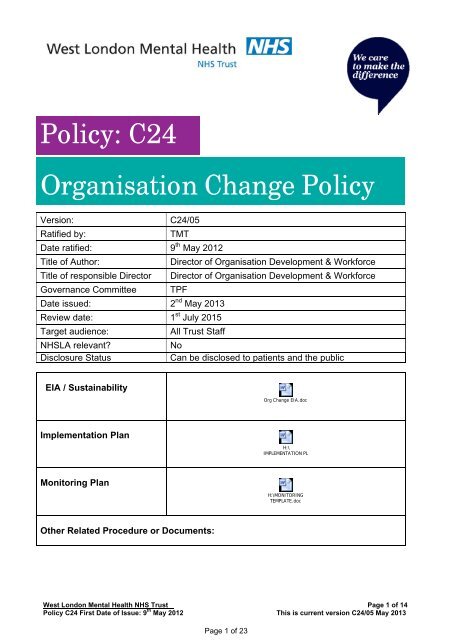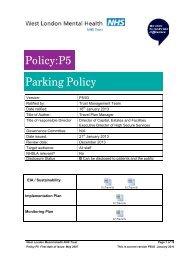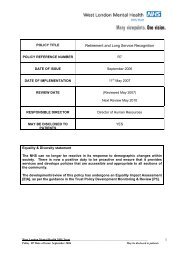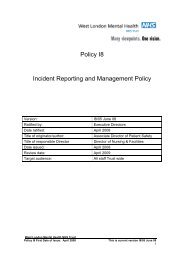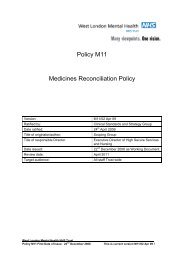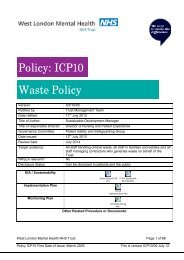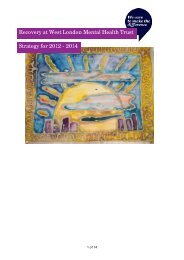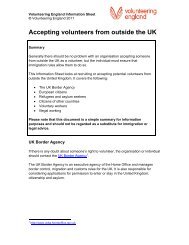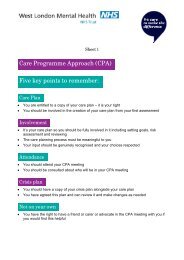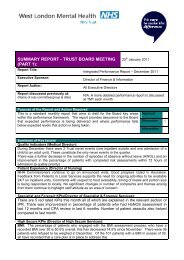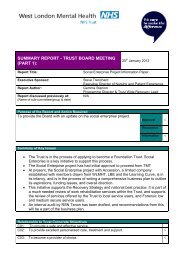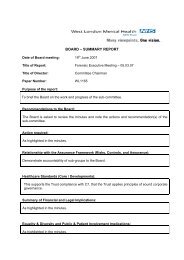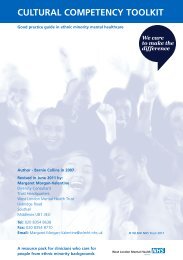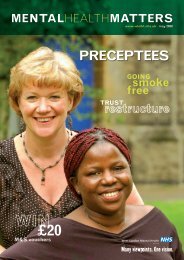C24 - Change Management Policy - West London Mental Health ...
C24 - Change Management Policy - West London Mental Health ...
C24 - Change Management Policy - West London Mental Health ...
Create successful ePaper yourself
Turn your PDF publications into a flip-book with our unique Google optimized e-Paper software.
<strong>Policy</strong>: <strong>C24</strong>Organisation <strong>Change</strong> <strong>Policy</strong>Version: <strong>C24</strong>/05Ratified by:TMTDate ratified: 9 th May 2012Title of Author:Director of Organisation Development & WorkforceTitle of responsible Director Director of Organisation Development & WorkforceGovernance Committee TPFDate issued: 2 nd May 2013Review date: 1 st July 2015Target audience:All Trust StaffNHSLA relevant?NoDisclosure StatusCan be disclosed to patients and the publicEIA / SustainabilityOrg <strong>Change</strong> EIA.docImplementation PlanH:\IMPLEMENTATION PLAMonitoring PlanH:\MONITORINGTEMPLATE.docOther Related Procedure or Documents:<strong>West</strong> <strong>London</strong> <strong>Mental</strong> <strong>Health</strong> NHS Trust Page 1 of 14<strong>Policy</strong> <strong>C24</strong> First Date of Issue: 9 th May 2012 This is current version <strong>C24</strong>/05 May 2013Page 1 of 23
Equality & Diversity statementThe Trust strives to ensure its policies are accessible, appropriate and inclusive for all.Therefore all policies will be required to undergo an Equality Impact Assessment and willonly be approved once this process has been completedSustainable Development StatementThe Trust aims to ensure its policies consider and minimise the sustainable developmentimpacts of its activities. All policies are therefore required to undergo a SustainableDevelopment Impact Assessment to ensure that the financial, environmental and socialimplications have been considered. Policies will only be approved once this process hasbeen completed<strong>West</strong> <strong>London</strong> <strong>Mental</strong> <strong>Health</strong> NHS Trust Page 2 of 14<strong>Policy</strong> <strong>C24</strong> First Date of Issue: 9 th May 2012 This is current version <strong>C24</strong>/05 May 2013Page 2 of 23
Version Control SheetVersion Date Title of Author Status Comment1 17.02.12 R Lewis Draft Tabled at TPF, forconsultation1.1 27.04.12 R Lewis Final Tabled at TPF on26.04.12,<strong>C24</strong>/05 10/05/1202/04/13Director of OrganisationDevelopment &WorkforceRatified TMT9th May 2012Previous changemanagement policy.<strong>Change</strong>s to includetext to ensure EIA’sare undertaken.<strong>Policy</strong> re-issued02/05/13<strong>West</strong> <strong>London</strong> <strong>Mental</strong> <strong>Health</strong> NHS Trust Page 3 of 14<strong>Policy</strong> <strong>C24</strong> First Date of Issue: 9 th May 2012 This is current version <strong>C24</strong>/05 May 2013Page 3 of 23
CONTENTSPage1 <strong>Policy</strong> Statement 52 Purpose 53 Scope 54 Principles 65 Consultation Requirement 76 Responsibilities 77 Appeals 88 Monitoring 8AppendicesAppendix 1 - Procedure for Managing Organisation <strong>Change</strong>9<strong>West</strong> <strong>London</strong> <strong>Mental</strong> <strong>Health</strong> NHS Trust Page 4 of 14<strong>Policy</strong> <strong>C24</strong> First Date of Issue: 9 th May 2012 This is current version <strong>C24</strong>/05 May 2013Page 4 of 23
1.0 INTRODUCTION - POLICY STATEMENT1.1 This policy forms part of <strong>West</strong> <strong>London</strong> <strong>Mental</strong> <strong>Health</strong> NHS Trust’s commitment tocreate a positive culture of respect for all individuals including staff, patients, theirfamilies and carers as well as community partners. The intention is to identify,remove or minimise discriminatory practice in the areas of race, disability, gender,sexual orientation, age and ‘religion, belief, faith and spirituality’ as well as topromote positive practice and value the diversity of all individuals and communities.1.2 This policy sets out <strong>West</strong> <strong>London</strong> <strong>Mental</strong> <strong>Health</strong> NHS Trust’s procedures formanaging organisation change to ensure that change is handled in a way that issensitive, consistent, fair and in line with statutory requirements and best practice.It seeks to balance the paramount need for fairness and full staff involvement withthe aim of ensuring that the organisation can be efficient and flexible in the way itresponds to an ever-changing environment.2.0 PURPOSE2.1 To provide a framework by which the Trust will implement any proposed change tothe nature and size of its workforce.2.2 To provide detailed guidance on the steps to be taken during organisation change.2.3 To ensure fairness and equity throughout the process, ensuring employees are wellsupported and treated sensitively at all times.2.4 To protect the continued employment of staff, wherever possible, and safeguardstaff morale.2.5 To ensure compliance with relevant legislation.2.6 To ensure employees affected by organisation change are not discriminatedagainst, either directly or indirectly, on the grounds of race, age, nationality, ethnicorigin, gender, sexual orientation, marital status or disability.3.0 SCOPE3.1 This policy applies to any individual, department or Trust wide organisation changeor restructuring which may result in significant changes to role, responsibility and/orwhere job losses may result.3.2 Every instance of organisation change is different; however the potentialramifications will determine into which of the following three categories it falls:Ongoing Minor <strong>Change</strong>In order to adapt to changing requirements, it is likely that <strong>West</strong> <strong>London</strong> <strong>Mental</strong><strong>Health</strong> NHS Trust will need to make periodic changes to roles, responsibilitiesand/or working practices. Staff will, therefore, be expected to accept reasonablechanges appropriate to the level of their post.<strong>West</strong> <strong>London</strong> <strong>Mental</strong> <strong>Health</strong> NHS Trust Page 5 of 14<strong>Policy</strong> <strong>C24</strong> First Date of Issue: 9 th May 2012 This is current version <strong>C24</strong>/05 May 2013Page 5 of 23
<strong>Change</strong> affecting job security<strong>Change</strong>s that may affect job security, resulting in potential job losses orredeployments include:• Organisational reorganisations, restructures or mergers• Reductions in, or discontinuations of, specific areas of work• Major changes to working practices or contractual terms<strong>Change</strong> across organisational boundariesWhere organisational changes require staff to be transferred from one employer toanother, the Transfer of Undertakings (Protection of Employment) Regulations,(TUPE), and subsequent amendments, will apply.Under these arrangements, the employees’ continuity of employment will bepreserved, along with all their contractual terms and conditions of employment andany collective agreements that apply.4.0 PRINCIPLES4.1 All organisation change processes that might impact on job security for any affectedstaff will be the subject of formal consultation and regular communication with staffand their Trade Union or professional association representatives. Staff will beactively encouraged to seek advice and support from their representatives.4.2 All major change processes must go through an equality impact assessment [EIA],to see if the change proposed, has a differential impact for staff that haveprotected characteristics, as defined by the Equality Act 2010. The themes thathave arisen as a result of the EIA should be highlighted within the consultation, sothat staff have an opportunity to respond to these trends, and raise any otherdiversity concerns that they may have. The EIA must be approved by the DiversityUnit before consultation. Please use the Equality Impact Assessment tool attachedat appendix 2.4.3 Consultation with staff and representatives will take place at the earliest opportunityand will provide opportunity for full contribution towards discussions. Adequate timewill be given in which to respond and feedback to be given. All reasonable effortswill be made to consult with staff away from work on extended leave (e.g. maternityleave, sick leave).4.4 Where reductions in staffing levels are necessary, the Trust will take all reasonablesteps to redeploy staff to suitable alternative employment and avoid redundancies.4.5 The Trust will seek to maximise the opportunities for existing staff to apply for postsin the new structure, giving prior consideration to existing post holders.4.6 Where job losses may result, the statutory requirements for disclosure ofinformation and notification to Trades Unions and the Department for Trade andIndustry will apply.4.7 Following formal consultation, a clear implementation plan will be communicated toall affected parties. Staff will be offered one-to-one meetings to discuss thepersonal impacts of the change/s.<strong>West</strong> <strong>London</strong> <strong>Mental</strong> <strong>Health</strong> NHS Trust Page 6 of 14<strong>Policy</strong> <strong>C24</strong> First Date of Issue: 9 th May 2012 This is current version <strong>C24</strong>/05 May 2013Page 6 of 23
4.8 The Trust will provide support to staff from Occupational <strong>Health</strong>, Staff SupportServices and HR representatives. Access to Trade Union and/or professionalassociation representatives will also be made available.4.9 Staff of all grades who have left the employment of the Trust on redundancy orearly retirement (whether voluntary or compulsory) will not normally be re-employedby the Trust in either a substantive, bank or agency capacity. Exceptions may bemade where there is an urgent requirement for staff with particular skills andexperience and there are compelling service and cost benefits to re-employing suchstaff. Such arrangements will need to be of a fixed term nature (normally no longerthan 6 months) and will need to be approved by the appropriate director.5.0 CONSULTATION REQUIREMENTS5.1 Ongoing Minor <strong>Change</strong> - where such changes are required, the reasons for thesewill be discussed with staff and they will be given the opportunity to state their viewsand suggest any alternative solutions as part of a localised, informal consultationprocess. Training will be provided where necessary to equip staff with any newknowledge or skills they may require. Affected individuals will be given reasonablenotice of the change and be supported, as far as practical, to adapt to the new wayof working. Further information is given in the Organisation <strong>Change</strong> Procedure(appendix 1).5.2 <strong>Change</strong>s affecting job security – a more formalised consultation process will takeplace in such situations, including formal notification to, and engagement with, localTrade Union representatives. Prior to the commencement of consultation, suchchanges must be supported by a business case agreed by the Trust Executive<strong>Management</strong> Team. The ensuing steps and timescales for consultation are laid outin the Organisation <strong>Change</strong> Procedure (Appendix 1).The minimum requirements for formal consultation where redundancies are plannedare as follows:• 90 days before the first redundancy is to be effected where it is proposed todismiss 100 or more staff within a 90 day period or less• 30 days before the first redundancy is to be effected where it is proposed todismiss between 20 and 99 staff (inclusive), within a 90 day period or less• Where fewer than 20 staff are to be dismissed there is no legal time limit withinwhich formal consultation must be carried out. However, consultation mustbegin at the earliest opportunity (as soon as serious consideration is given toany potential redundancies).5.3 <strong>Change</strong> across organisational boundaries (TUPE)There is no legal minimum period for formal consultation where a Transfer ofUndertakings is proposed, however consultation must be meaningful and allowsufficient time for staff and representatives to consider the proposals.The Trust is committed to ensuring that it will negotiate with other providers toensure that the TUPE regulations are applied where areas of service aretransferred and the Transfer is deemed to be covered by the regulations.<strong>West</strong> <strong>London</strong> <strong>Mental</strong> <strong>Health</strong> NHS Trust Page 7 of 14<strong>Policy</strong> <strong>C24</strong> First Date of Issue: 9 th May 2012 This is current version <strong>C24</strong>/05 May 2013Page 7 of 23
6.0 DUTIES6.1 Manager’s Responsibilities• To treat all employees affected by organisation change with fairness and equity• Where formal consultation is required, to ensure a robust plan for any proposedorganisation change is prepared for consultation with staff. This should includean approved equality impact assessment, information on proposed changes toorganisation structures and preparation of a business case and/or consultationpaper, as necessary. Notify the Staff Side Chair and set-up collectiveconsultation meeting/s with staff, staff side and the relevant HR representative.• To give proper consideration to staff’s views expressed during consultationprocesses, giving appropriate feedback.• To seek advice and guidance from the relevant HR representative6.2 Employee’s Responsibilities• To seek advice from their Trade Union, professional association or HRrepresentative if they require clarification on any part of the Organisation<strong>Change</strong> <strong>Policy</strong> and any potential impacts on their own situation• To participate in consultation processes in a constructive and timely manner,attending planned meetings as required• To give full consideration to all offers of suitable alternative employment and toundertake such training as may be necessary in order to undertake the new roleeffectively. (A trial period of 4 weeks will be provided).6.3 HR Department Responsibilities• To provide support and expertise to managers and staff during periods oforganisation change, ensuring adherence to the Organisation <strong>Change</strong> <strong>Policy</strong>and Procedure and compliance with relevant legislation.• To provide advice and guidance to staff facing redundancy in respect ofcompleting application forms and interview technique, where requested.6.4 Pensions Department Responsibilities• To provide information and advice to employees and managers as requested onredundancy and early retirement calculations.6.5 Occupational <strong>Health</strong> Department Responsibilities• To provide health and counselling support to employees subject to organisationchange as required.6.6 Diversity Unit Responsibilities• To provide support and advice in the completion of equality impactassessments and to approve equality impact assessments.7.0 APPEALS7.1 Any dispute arising from the application of this <strong>Policy</strong> shall be heard in accordancewith the Trust’s Grievance and Dispute Procedure (G1).7.2 Appeals against a decision to select an individual for redundancy will be heard inaccordance with the Trust’s Appeal Procedure contained within the Trust’sGrievance and Dispute Procedure (G1). The purpose of such an appeal is toestablish whether the manager has acted reasonably.<strong>West</strong> <strong>London</strong> <strong>Mental</strong> <strong>Health</strong> NHS Trust Page 8 of 14<strong>Policy</strong> <strong>C24</strong> First Date of Issue: 9 th May 2012 This is current version <strong>C24</strong>/05 May 2013Page 8 of 23
8.0 MONITORING8.1 In line with NHS Guidance the Trust’s Remuneration Committee receivesinformation about redundancies and the redeployments linked to minimisingredundancies.<strong>West</strong> <strong>London</strong> <strong>Mental</strong> <strong>Health</strong> NHS Trust Page 9 of 14<strong>Policy</strong> <strong>C24</strong> First Date of Issue: 9 th May 2012 This is current version <strong>C24</strong>/05 May 2013Page 9 of 23
Appendix 1PROCEDURES FOR MANAGING ORGANISATION CHANGE1.0 CONSULTATION PROCEDURES1.1 Consultation, whether formal or informal, is an essential component of organisationchange. It allows for clear communication and a process for obtaining feedback fromvarious stakeholders, not least the individuals directly employed in the area wherechange is to be effected.1.2 Ongoing Minor <strong>Change</strong> – section 5.1 of the Organisation <strong>Change</strong> <strong>Policy</strong> applies. Thisinformal consultation would involve:• An open staff meeting where reasons for the change are communicated, and staffgiven opportunity to raise concerns and ask initial questions• A period of time (7 to 14 days) for staff to reflect on the change, ask any furtherquestions and give full feedback. Staff will be reminded of the option to approachtheir trade union or professional association representative for advice, if they sowish• At the end of the informal process, the line manager would state the outcome ofthe consultation process and communicate an effective date for the change1.3 <strong>Change</strong> affecting Job Security – this would involve a formal consultation process,entailing:• A business case approved by the Trust Executive <strong>Management</strong> Team• Notification to, and engagement with, staff representatives• The production of a change management paper setting out the rationale andimpact/s of the organisation change• One or more (as necessary) staff meetings to present the change managementpaper, explain the rationale and impact/s of the change and give an opportunityfor staff to ask initial questions• A period of time (15 to 28 days) for staff to reflect on the change, ask any furtherquestions and give full feedback• At the end of the process, the line manager would state the outcome of theconsultation process and communicate an effective date for the change. Staffshould be offered one-to-one meetings to discuss the personal impacts of thechange/s.Where redundancies are planned as part of an organisation change, consultationarrangements are superseded by the ‘minimum requirements for redundancyconsultation’, contained within 5.2 of the Organisation <strong>Change</strong> <strong>Policy</strong>.1.4 <strong>Change</strong> across Organisation boundaries – as stated in 5.3 of the Organisation<strong>Change</strong> <strong>Policy</strong>, TUPE does not impose any specific timescales for consultation.However, consultation with affected staff and their representatives must take place in away that is meaningful and allows sufficient time for them to consider the proposals.The process of consultation should involve both the ‘receiving’ organisation, and thetransferor organisation. Any representations made by the staff and/or theirrepresentatives must be duly considered and any reasons for rejection must be stated.<strong>West</strong> <strong>London</strong> <strong>Mental</strong> <strong>Health</strong> NHS Trust Page 10 of 14<strong>Policy</strong> <strong>C24</strong> First Date of Issue: 9 th May 2012 This is current version <strong>C24</strong>/05 May 2013Page 10 of 23
2.0 REDEPLOYMENT / SUITABLE ALTERNATIVE EMPLOYMENT PROCEDURES2.1 Where restructuring takes place, a logical, fair and transparent process will be put inplace to fill posts in the new structure. This will take place as follows:2.2 In order to maximise opportunities for all existing staff, new structures will normally befilled from ‘the top down’. All staff will be notified of promotional opportunities and beinvited to apply for any higher-level posts via the standard recruitment process. Thismay be in competition with external candidates, as long as any external appointment/swould not result in an existing team member being displaced. If there is a risk ofexisting staff being displaced as part of this process, the posts in the new structure willbe ‘ringfenced’ and existing staff of a similar or higher grade will be given priorconsideration over other potential candidates.2.3 Next, members of staff will be automatically ‘slotted-in’ to a post in the new structurewhere:• Their substantive post remains largely unchanged (70% of their currentresponsibilities can be identified in a post in the new structure at a similar orlower grade).• There is no significant grade or salary change.• The number of similar available posts and postholders are equal.‘Slotting-in’ status will be applicable to part-time posts that meet all the above criteriawhere there is no significant increase or decrease in hours.Once a member of staff has been slotted-in, they will no longer be deemed to be at riskand will therefore be precluded from applying for other posts until all existing staff havebeen accommodated in the new structure, unless a promotional opportunity becomesavailable.All individuals who are slotted-in will meet with the relevant line manager to exploreperceptions about the new role and to discuss, review and agree any training ordevelopment needs.2.4 Where ‘slotting-in’ cannot take place (due to an imbalance between the number of postsand postholders) a selection process with clear criteria will be put in place.2.5 All unfilled posts in the new structure will be ringfenced and staff will be informed of theprocess by which they should express preference(s) for vacant posts. Staff should notbe required to “apply for their own jobs”, and slotting-in should occur wherever possible.However, if there is to be a reduction in the number of like or similar posts, thenmanagement and staff representatives should agree the means of appointingindividuals to vacant positions. This may include the application of selection criteria; aninterview-type or assessment centre selection process.2.6 Trial Periods2.6.1 All staff selected for a new post in the structure, other than those slotted-in, will have theright to a four-week trial in the post. This is to allow the individual time to make ainformed decision regarding the suitability of the post, as well as for the Trust to assesswhether the member of staff is suitable for the post. Either party may decide toterminate the trial period.<strong>West</strong> <strong>London</strong> <strong>Mental</strong> <strong>Health</strong> NHS Trust Page 11 of 14<strong>Policy</strong> <strong>C24</strong> First Date of Issue: 9 th May 2012 This is current version <strong>C24</strong>/05 May 2013Page 11 of 23
2.6.2 Full discussions regarding role, responsibilities, induction and support arrangementsshould take place before the trial period is undertaken. The trial period will give themember of staff the opportunity to determine whether the new job is suitable withoutnecessarily losing the right to redundancy pay.2.6.3 Regular feedback should be given to the employee during the trial period.2.6.4 An extension to the trial period can be agreed, if it is felt that this would be in the bestinterests of the member of staff and the Trust. Whilst this would normally be for nomore than a further four weeks, longer periods may be appropriate for more seniorroles.2.6.5 If successful, the member of staff will be confirmed in the new post. If unsuccessful, theTrust will explore other options for suitable alternative employment with the member ofstaff. However, this may not be possible in all cases.2.7 Protection of Pay and Conditions2.7.1 If, as a consequence of organisation change an employee is required to move to a postthat attracts a lower salary or lower level of regular earnings, protection arrangementswill apply. These provisions apply only to employees on AfC or Trust terms andconditions.2.7.2 Protection of salary includes basic pay and any geographical allowance/s only.Protection of earnings also includes additional allowances, e.g. on-call and unsocialhours payments, based on a 3-month average prior to the commencement of protection.The specific periods of protection are related to continuous NHS Service and aredetailed below:Length of continuous NHS Service Period of protection for enduringelements of payLess that 12 months service3 months protection12 months - less than 24 months 6 months protectionservice2 years - less than 5 years service 12 months protection.5 years – less than 10 years service 18 months protection10+ years service 24 months protectionLength of continuous NHS Service Period of protection for “averagedprotectable“ elements of payUnder 12 months2 months1-2 years 4 months2-3 years 6 months3-4 years 8 months4-5 years 10 months5+ years 12 months2.7.3 Protection of earnings/salary will always mean protection on a marked-time basis andprotection will always end when the salary and/or earnings in the new post equals orexceeds the protected salary and/or earnings.<strong>West</strong> <strong>London</strong> <strong>Mental</strong> <strong>Health</strong> NHS Trust Page 12 of 14<strong>Policy</strong> <strong>C24</strong> First Date of Issue: 9 th May 2012 This is current version <strong>C24</strong>/05 May 2013Page 12 of 23
At the end of the protection period, the basic salary will revert to that of the lowergradedpost (appropriate inflationary increases will apply).2.7.4 A lump sum payment, as an alternative to protection, may be negotiated on anindividual basis, along with claw back arrangements in the event that the individualleaves the Trust within a relatively short time frame.2.7.5 Staff will be encouraged to apply for appropriate posts of a higher salary/grade as andwhen they arise during the protection period. Protection will cease if the employeevoluntarily moves to a new post.2.8 Refusal of Suitable Alternative EmploymentThe Trust is committed to minimising redundancies and will facilitate redeployment.Should an employee unreasonably refuse an offer of suitable alternative employment,they may be disentitled from receiving a redundancy payment.2.9 Travelling Expenses2.9.1 Excess travel expenses will be paid in accordance with normal arrangements to staffwho are required to change their base of work as a consequence of organisationchange.2.9.2 Staff required to work on a temporary basis on a site that is not their normal base will bereimbursed excess daily travel expenses for the duration of their temporary placement(public transport rate).2.9.3 Staff required to change their base permanently will be reimbursed excess travelexpenses for a period of up to one year (public transport rate).2.9.4 Staff required to change their base permanently and for whom travelling on a dailybasis from their present home is impractical, may at the discretion of the Trust beeligible for Removal Expenses in accordance with the provisions of the said policy.2.9.5 Staff required to change their base on either a temporary or permanent basis, if theychoose not to move home, may be given an allowance of time per day for travelling,provided they can demonstrate that they experience significant additional travellingtime. The allowance will be excess time spent on travelling, over and above existingtravelling time, up to a maximum of one hour per day for the first six months (or thewhole of the period of temporary transfer), and 30 minutes thereafter for a further sixmonths for staff transferred on a permanent basis. This will either be paid at thestandard rate of pay or given as reduced working hours in line with the needs of theservice and the individual concerned. Time for travelling cannot be accrued as ‘timeowing’.3.0 REDUNDANCY PROCEDURES3.1 Redundancy is a last resort and the Trust will seek to avoid compulsory redundanciesby the following means:• Natural turnover• Suspension and/or restriction of recruitment to vacancies• Review of overtime and other working arrangements<strong>West</strong> <strong>London</strong> <strong>Mental</strong> <strong>Health</strong> NHS Trust Page 13 of 14<strong>Policy</strong> <strong>C24</strong> First Date of Issue: 9 th May 2012 This is current version <strong>C24</strong>/05 May 2013Page 13 of 23
• Redeployment and retraining where appropriate• Voluntary redundancy/early retirement• Non-renewal of temporary contracts• Reduction in the use of agency and bank staff in areas where posts are at riskAny other proposal/s submitted by staff, staffside, or management, aimed at avoidingredundancies, will be considered.3.2 Where staff are displaced as a result of organisation change either as by means of adirect reduction in the number of posts, or that they are unable to be accommodated ina new structure via the redeployment process outlined above, they will be deemed to be‘at risk’ of redundancy.3.3 In these circumstances, contractual notice will be given and full consideration will begiven as to whether the individual can be redeployed to suitable alternative employmentto another post elsewhere in the Trust. This redeployment process will be equal to, andrun concurrently with, an individual’s contractual notice period. This may be extended inexceptional circumstances.3.4 As soon as possible after an individual has been identified as being displaced, their linemanager will arrange to meet with them to inform them of the following:• The Trust’s intention to dismiss them for reasons of redundancy• Their redundancy terms• The assistance they will be given, as outlined below• The effective date of dismissal• The reason for the redundancy• The process for considering suitable alternative employment, as outlined in 3.33.5 Displaced employees will normally be expected to work their notice period and take anyoutstanding annual leave during this period. It may however, be possible for employeesto be released early where it is in the best interests of both the Trust and the employee.3.6 In the event of organisation change that could result in job losses, staff may be offeredthe opportunity of taking voluntary redundancy or early retirement on the grounds ofredundancy. This may be a more sensitive method of achieving the necessaryreduction in workforce numbers. Staff from within the staff group affected by theorganisation change, or from within the same employment category, may be invited toapply.3.7 Where voluntary redundancy is to be offered, management in the departmentconcerned, assisted by a Human Resources representative, will specify the selectioncriteria to be used. Selection shall be made by the relevant Senior Manager/Directorand a Human Resources representative. Should voluntary redundancy include anentitlement to premature retirement benefits under the NHS Pension Scheme,acceptance of the volunteer will require approval that funding is available to support therequest. The Trust is under no obligation to accept voluntary redundancy requests.3.8 During any period of notice of redundancy, staff will be entitled to reasonable time offduring working hours, subject to the granting of permission, to look for new employmentor make arrangements for training/retraining.<strong>West</strong> <strong>London</strong> <strong>Mental</strong> <strong>Health</strong> NHS Trust Page 14 of 14<strong>Policy</strong> <strong>C24</strong> First Date of Issue: 9 th May 2012 This is current version <strong>C24</strong>/05 May 2013Page 14 of 23
3.9 The entitlements to redundancy payments for staff are either those set out in section 45of the General Whitley Council Conditions of Service, or section 16 of the Agenda for<strong>Change</strong> Handbook, as appropriate, or statutory provisions where they are morefavourable.3.10 If a member of staff accepts a suitable alternative position with another NHS employerwithin 28 days of the effective date of termination of employment, then this is regardedas redeployment and no redundancy payment is due.<strong>West</strong> <strong>London</strong> <strong>Mental</strong> <strong>Health</strong> NHS Trust Page 15 of 14<strong>Policy</strong> <strong>C24</strong> First Date of Issue: 9 th May 2012 This is current version <strong>C24</strong>/05 May 2013Page 15 of 23
Appendix 2Equality Impact Assessment Screening Tool - To be completed and sent to the Diversity Unit forapproval1. Name of the policy/servicedevelopment being assessed?Comments2.Name of the person responsible forcarrying out the assessment?3. What is the aim/objective or purposeof the policy/service development?Please include a summary of thepolicy/servicedevelopment/strategy/plan beingconsidered, specifying the changeenvisaged and the reason for thechange4. What is the overall benefit of theproposed objective?.Reason for change:Specify change:Proposed benefit:• e.g. increased efficiency,• cost savings,• increased access to service etc.5. What is the expected impact (eitherpositive or negative) of thepolicy/service change for the groupslisted below? Please tick affectedgroup and supply examples.[positive=P; negative=N] Look at thisfrom both an (i) organisationalperspective; will there be a change inthe workforce profile as a consequenceof this change e.g. reduction in thenumber of female/bme seniormanagers and (ii) individualperspective; would a disabled memberof service user/staff experience aincrease or decrease in access to aservice /employment prospects• e.g. advantage/disadvantage ofchange in location;• staffing levels;• increased access to servicesProtected Characteristics• Age P N Significant Slight None• Disability- learning disabilities, physicaldisability, sensory impairment and mentalhealth problems P NSignificant Slight NoneGender P N Significant Slight None<strong>West</strong> <strong>London</strong> <strong>Mental</strong> <strong>Health</strong> NHS Trust Page 16 of 14<strong>Policy</strong> <strong>C24</strong> First Date of Issue: 9 th May 2012 This is current version <strong>C24</strong>/05 May 2013Page 16 of 23
Race P N Significant Slight NoneReligion or belief P N Significant Slight None• Sexual orientation including lesbian, gayand bisexual people P NSignificant Slight None• Gender Re-assignment Significant Slight None• Marriage & Civil Partnership Significant Slight None• Pregnancy/Maternity rights Significant Slight None• Socio-economic disadvantage –Significant Slight NoneDuty to take account of the impact ofdecisions on outcomes experienced bydifferent groups e.g. access to [medical andhousing provisions] and their ability toparticipate in society [income,unemployment education].6. What information do you have on possiblepractices that impact on diversity andequality and how has this been collected?E.g. complaints data, Joint Strategic NeedsAssessments, demographic data, local/national research, staff/ service usersurvey, diversity monitoring data, oranecdotal information, service user forums,community meetings.7. What information could be collected inthe future to better inform future EIA’s?8. Does this policy/service developmentpromote equality by?[How does:(i)Eliminating discrimination;;(ii) Advancing Equality ofOpportunity;(iii)Fostering good relationshipsbetween different groups]Please explain how its activities assist inachieving the above outcomes and nameaffected groups9. (i) Has consultation been carried outto consider the potential impact ofequality on staff/service users? If so,Methodconsultation:ofDurationconsultation:of<strong>West</strong> <strong>London</strong> <strong>Mental</strong> <strong>Health</strong> NHS Trust Page 17 of 14<strong>Policy</strong> <strong>C24</strong> First Date of Issue: 9 th May 2012 This is current version <strong>C24</strong>/05 May 2013Page 17 of 23
please specify methods used andgroups consulted, when it occurredand duration of consultation;(ii) What are the key messages thathave arisen and whatconclusions/decisions have beenreached.Key equality anddiversity messages:e.g. Is there areduction in access fora particular groupbecause of increasedtravel.Conclusions/Decisions:10. Have the answers to the initial screeningindicated a positive or a negativeoutcome for different equality groups? Ifso please state if outcome is positive ornegative and specify the group, rating thelevel of impact (i.e. High = significantmedium = some and low = little ).PNGroup:HighsignificantP NGroup:Medium-someP NGroup:Low –LittleImpact may be affected by the followingfactors:• number of people affected;• extent of impact;• appropriateness of service;• accessibility of service.Please circle the right answer.N.b Please note that a negative impactdoes not always equate to discrimination.11.Please give details of any action to betaken to reduce the adverse impacthighlighted.EqualityTargetGroup:Actions:LeadPerson:TargetDate:12. Review timescales:3 months/6 months/12 monthsSignature:Job TitleDate:Approved by Diversity UnitDate:Please return this form to the Diversity Lead to approve.<strong>West</strong> <strong>London</strong> <strong>Mental</strong> <strong>Health</strong> NHS Trust Page 18 of 14<strong>Policy</strong> <strong>C24</strong> First Date of Issue: 9 th May 2012 This is current version <strong>C24</strong>/05 May 2013Page 18 of 23
Equality Impact Assessments (EIAs) - Guidance for ManagersWhat is an EIA?An EIA is a systematic approach to finding out whether a policy or a service change affects, or is likely toaffect, different groups of people in different ways, and identifies action necessary to improve equalityperformance.The groups include age, disability, gender reassignment, marriage and civil partnership, maternity andpregnancy, race, religion or belief, sex and sexual orientation.What is the purpose of an EIA?The purpose is to ‘equality–proof’ policies and practices by eliminating actual or potential discriminationand by identifying opportunities to promote equality.What benefits can EIAs bring to the Trust?The EIA process can enable us to integrate equality and diversity in service and policy design, developmentand review in very practical ways. The process underpins:• Fair and inclusive services, practices and workplaces• Well informed and robust decisions• A reduction in health inequalities• The elimination of discrimination• The Trust’s commitment to equality and diversity.Why must I carry out an EIA?Apart from realising the benefits outlined above, EIAs are a legislative requirement and form part of thepublic sector equality duties that the Trust must comply with. The Equality Act which will come into force on1 st October 2010 has extended the public equality duty to religion/belief, sexual orientation and age and alsointroduces the concept of socio-economic disadvantage.EIA ProcessEquality AnalysisThe first stage of the process involves identifying if there have been concerns about different outcomes fordifferences groups and, if such concerns exist, ensuring that whatever information is available is recorded.The issue that has become apparent from carrying out EIAs thus far is that the Trust does not gather thisinformation routinely and we have no systems in place for recording the information we need. Thereforesome of the actions, arising from the EIA process, have focused on putting systems into place so that thenext time the policy is reviewed we have the necessary information and can amend the policy as necessary.The second stage considers other information, which may have been obtained from staff and service userforums, workforce and patient data, and data from other stakeholders, national research and reports whichindicates a difference in experience for different groups. Consultation can be used to test out whether theproposed change is likely to impact specific groups, in the way that the available information is suggesting.Those responsible for carrying out the Equality analysis are required to demonstrate the actions taken toaddress the diversity issues identified. This could include amending the policy where necessary or ensuringthat the lessons learned from going through this process are fed back into training.Keep in mind• The focus is on outcomes for equality rather than just going through the process.• EIA looks for opportunities to promote equality, as well as eliminating discrimination.• EIA is not an exact science.• Information used to inform the EIA can be qualitative or quantitative, local or national.<strong>West</strong> <strong>London</strong> <strong>Mental</strong> <strong>Health</strong> NHS Trust Page 19 of 14<strong>Policy</strong> <strong>C24</strong> First Date of Issue: 9 th May 2012 This is current version <strong>C24</strong>/05 May 2013Page 19 of 23
1.Name of the policy/service developmentbeing assessed?CommentsInsert name of policy2.3.4.Name of the person responsible forcarrying out the assessment?What is the aim/objective or purpose ofthe policy/service development? Pleaseinclude a summary of the policy/servicedevelopment/strategy/plan beingconsidered, specifying the changeenvisaged and the reason for the changeWhat is the overall benefit of theproposed objective?.Insert name of responsible mangerReason for change:Insert rational for changeSpecify change:Describe proposal, specify changeenvisioned.Proposed benefit:• e.g. increased efficiency,• cost savings,• increased access to service.5.What is the expected impact (eitherpositive or negative) of the policy/servicechange for the groups listed below?Please tick affected group and supplyexamples and circle either[P=positive; N=negative]. Indicate yourview of the expected impact as eithersignificant, slight, none. E.g.Possible impact:• advantage/disadvantage of change inlocation; resulting in more/less time intravelling to location.• staffing levels, patient group mayrequire different skill set;• increased/deceased access toservice.The aim of this question is to raise issues ofconcern, so that the Trust can addressthese issues and consider changingpractice to mitigate the possible effects.Some groups may hold particular beliefs orhave concerns that may result in yourservice being less accessible or not beingaccessed at all. Some may have aperception that the policy is beinginappropriately applied to them. If you areaware of any previous issues/incidentswhich indicate that there could be concernsfor particular groups of staff or patients,even if you are not sure about the possibleimpact on the implementation of thechange, you should record it, so that it canbe tested out during the consultation,circling the ‘N’ by the group that you haveidentified, using the headings given below.N.b. identifying such issues, does not meanthat the policy/practise is unlawful.It could also be the case that you believethat your policy/servicechange/redevelopment will be morebeneficial to certain groups e.g. a new buildmay be more disability friendly. You shouldrecord the possible benefits, for the groupidentified, circling the ‘P’, which could thenbe identified as good practice andreplicated elsewhere to improve access forall.When considering the extent of the impactyou may consider the following factors:• Number of people affected,<strong>West</strong> <strong>London</strong> <strong>Mental</strong> <strong>Health</strong> NHS Trust• Extent of difficulty/ease in Page 20 of 14<strong>Policy</strong> <strong>C24</strong> First Date of Issue: 9 th May 2012 accessing service, This is current version <strong>C24</strong>/05 May 2013Page 20 of 23
• Additional costs incurred.Protected Characteristics• Age P N Significant Slight None• Disability- learning disabilities, physicaldisability, sensory impairment and mentalhealth problems P NSignificant Slight None• Gender P N Significant Slight None• Race P N Significant Slight None• Religion or belief P N Significant Slight None• Sexual orientation including lesbian, gayand bisexual people P NSignificant Slight None• Gender Re-assignment Significant Slight None• Marriage & Civil Partnership Significant Slight None• Pregnancy/Maternity rights Significant Slight None• Socio-economic disadvantage –Duty to take account of the impact ofdecisions on outcomes experienced bydifferent groups e.g. access to [medical andhousing provisions] and their ability toparticipate in society [income,unemployment education].6. What information do you have onpossible practices that impact ondiversity and equality and howhas this been collected? E.g.complaints data, Joint StrategicNeeds Assessments, demographicdata, local/ national research, staff/service user survey, diversitymonitoring data, or anecdotalinformation, service user forums,community meetings.7.What information could be collected in thefuture to better inform future EIA’s?Significant Slight NoneYou may hold local or national informationthat highlights the experiences of a certaingroup, which may effect the implementationof the policy/service development. Is thereany information contained in the annualstaff survey, CMI Census, audits orcomplaints that apply to specific groups?The information may even be anecdotal orraised informally but it still needs to berecorded as per question 5 above.Are there any potential issues that couldarise for different groups? It could be thatthere is a concern but no definiteinformation available. You therefore need tothink about what information you need to<strong>West</strong> <strong>London</strong> <strong>Mental</strong> <strong>Health</strong> NHS Trust Page 21 of 14<strong>Policy</strong> <strong>C24</strong> First Date of Issue: 9 th May 2012 This is current version <strong>C24</strong>/05 May 2013Page 21 of 23
collect (and how) in order to get a fullerpicture and to establish if this concern hasmerit or not.8. Does this policy/service developmentpromote equality?[How does it affect the following:(iv) Eliminate discrimination;(v) Advance Equality of; Opportunity;(vi) Foster good relationshipsbetween different groups]Please explain how its activities assist inachieving the above outcomes andname affected groups9. Has consultation been carried out toconsider the potential impact of equalityon staff/service users? If so, pleasespecify methods used and groupsconsulted, when it occurred and theduration of consultation;(ii) What are the key messages that havearisen and what conclusions/decisionshave been reached.10. Have the answers to the initial screeningindicated a positive or a negative outcome fordifferent equality groups? Please circle the ‘P’or ‘N’ accordingly, stating if the outcome ispositive or negative and specify the groupidentified, rating the level of impact (i.e. High= significant medium = some and low = little ).Method ofconsultation:Key equality anddiversity messages:e.g. Is there areduction in access fora particular groupbecause of increasedtravel.P N P NGroup:HighsignificantGroup:Medium-someDuration ofconsultation:Conclusions/Decisions:P NGroup:Low –LittleImpact may be affected by the followingfactors:• number of people affected;• extent of impact;• appropriateness of service;11.• accessibility of service.Please circle the right answer.N.b A negative impact does not alwaysequate to discrimination.Please give details of any action to be takento reduce the adverse impact highlighted.EqualityTargetGroup:Actions:LeadPerson:TargetDate:12.Review timescales:3 months/6 months/12 monthsSignature:Job TitleDate:<strong>West</strong> <strong>London</strong> <strong>Mental</strong> <strong>Health</strong> NHS Trust Page 22 of 14<strong>Policy</strong> <strong>C24</strong> First Date of Issue: 9 th May 2012 This is current version <strong>C24</strong>/05 May 2013Page 22 of 23
Approved by Diversity UnitDate:Please return this form to the Diversity Lead to approve.<strong>West</strong> <strong>London</strong> <strong>Mental</strong> <strong>Health</strong> NHS Trust Page 23 of 14<strong>Policy</strong> <strong>C24</strong> First Date of Issue: 9 th May 2012 This is current version <strong>C24</strong>/05 May 2013Page 23 of 23


